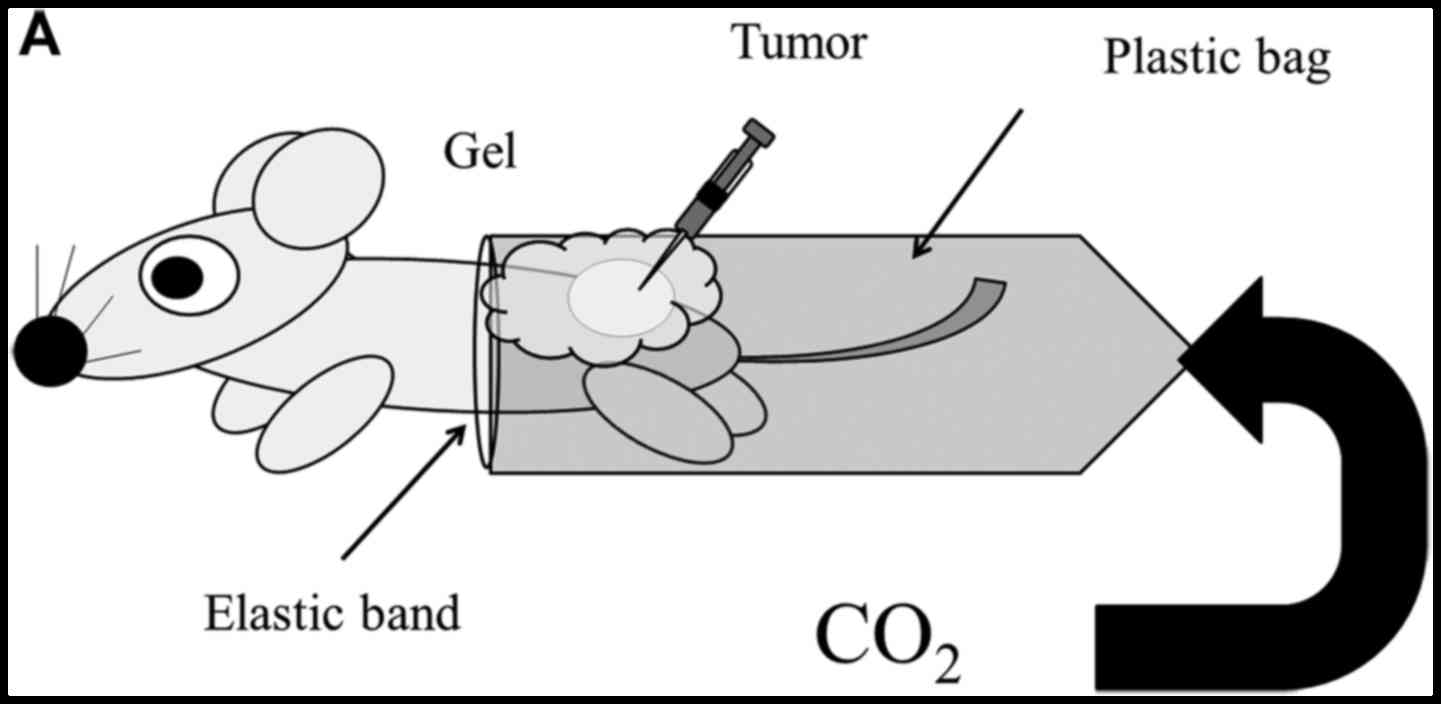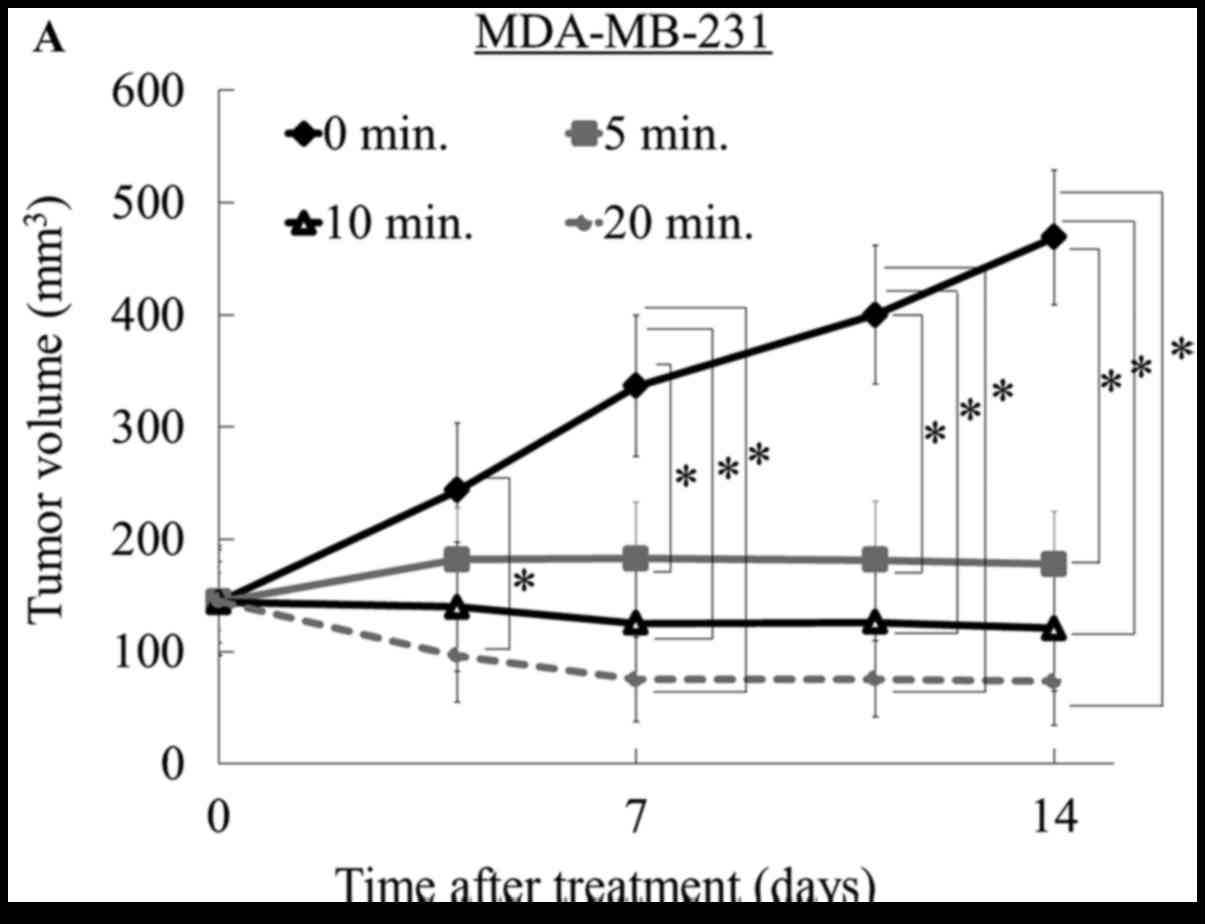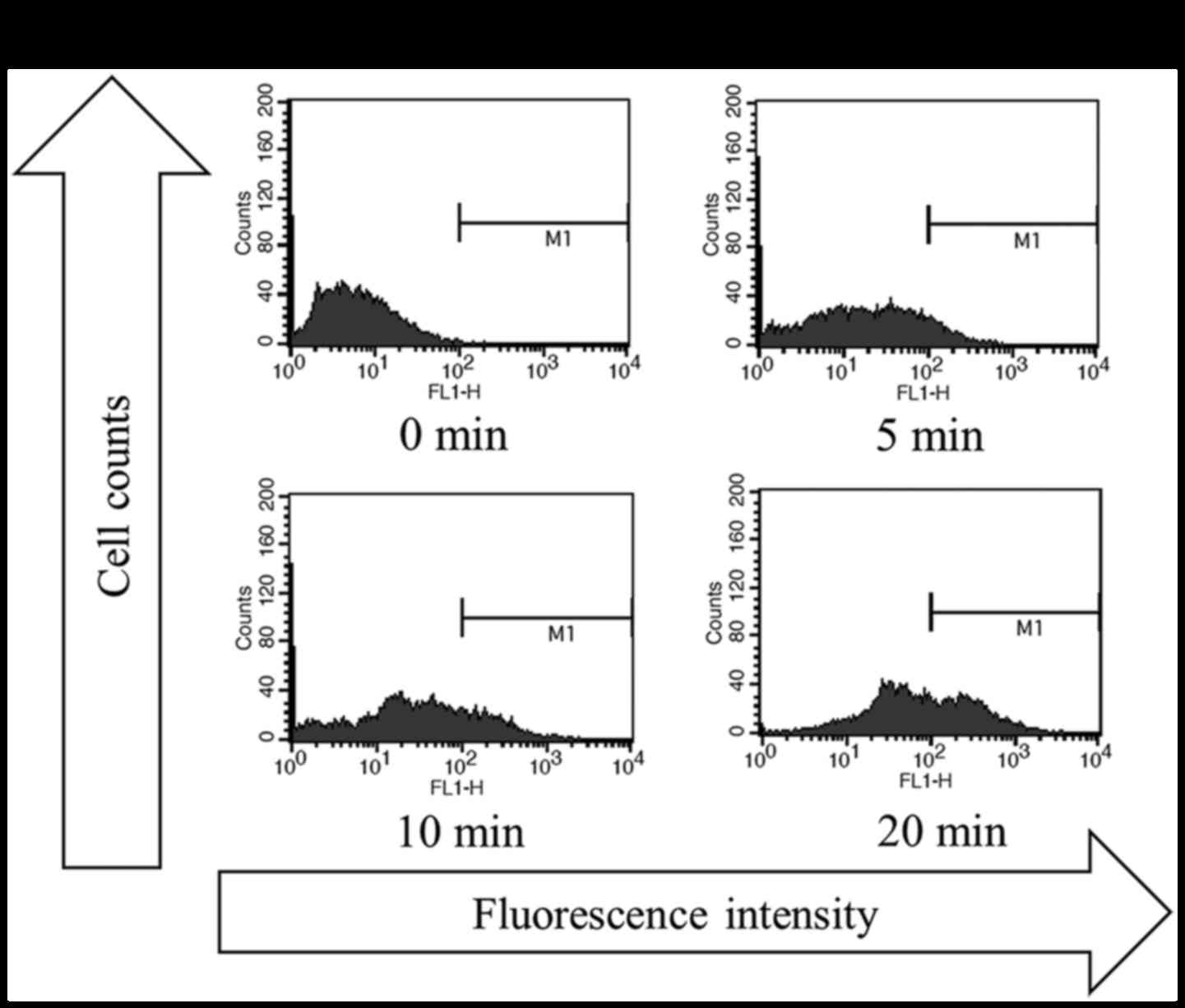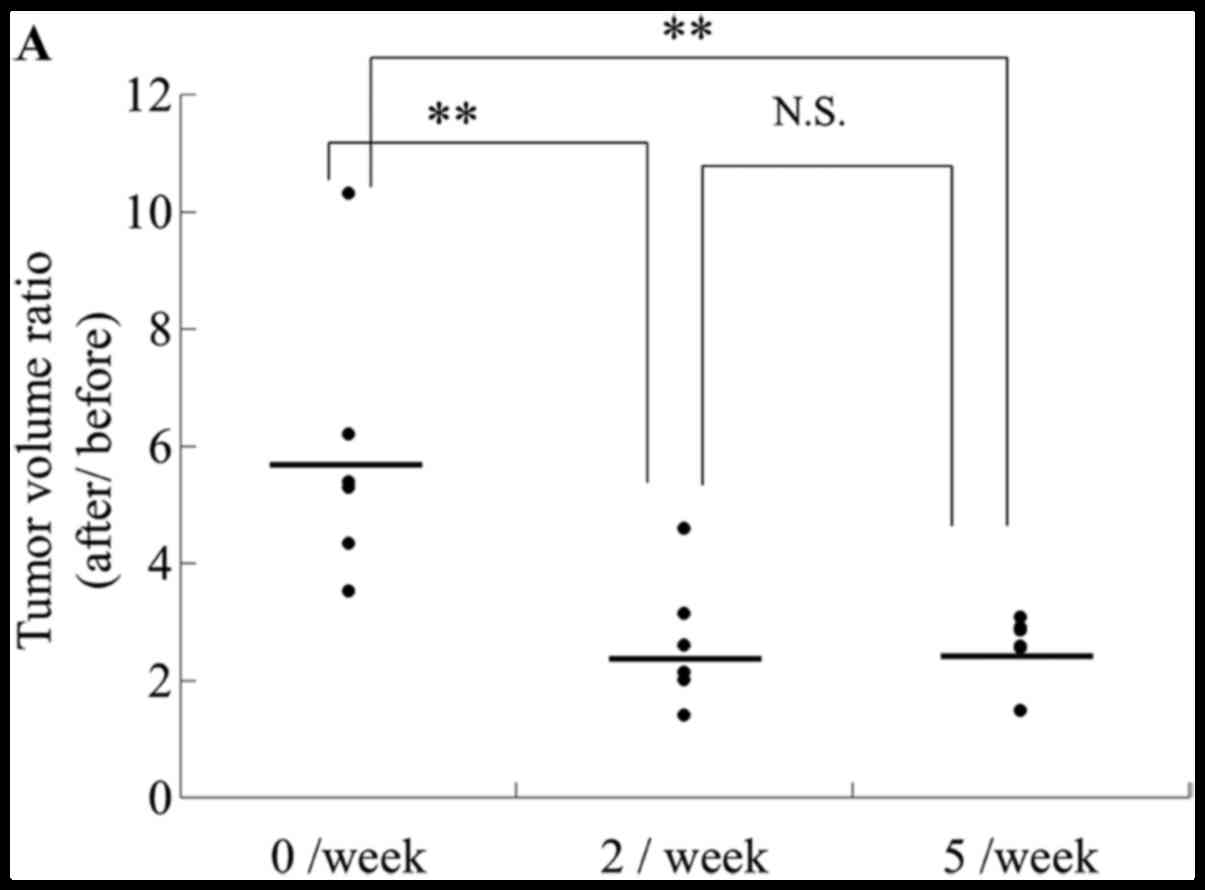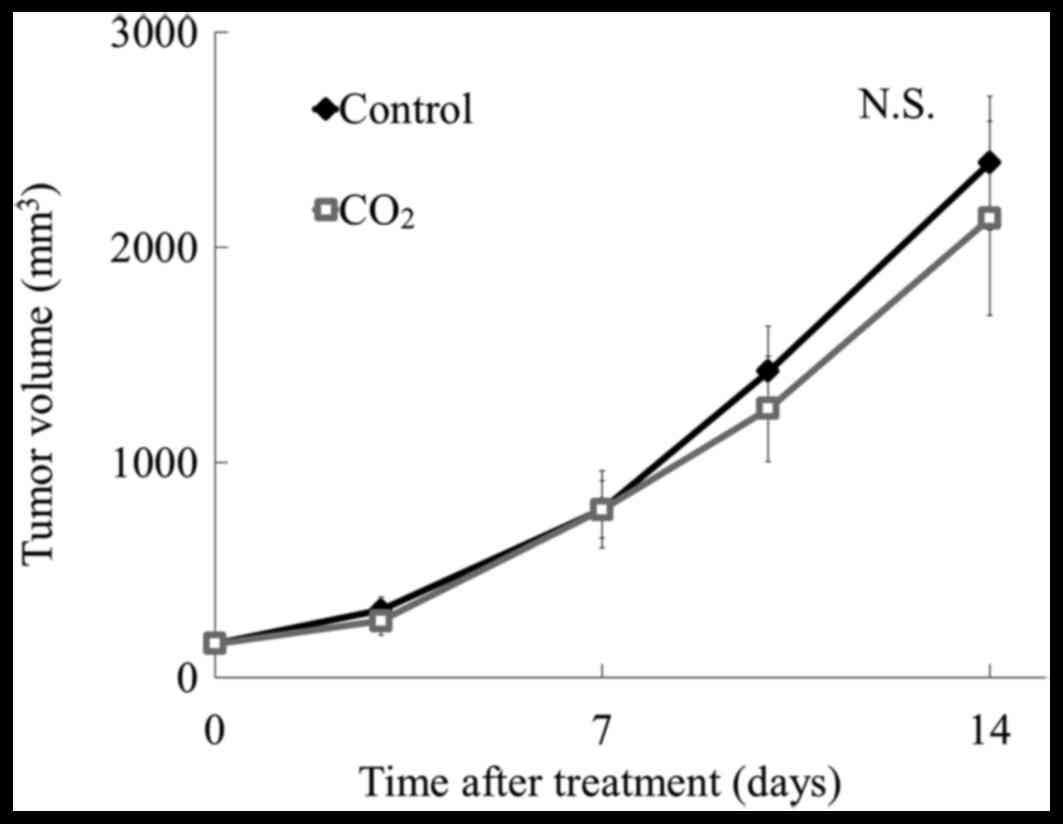Optimization of antitumor treatment conditions for transcutaneous CO2 application: An in vivo study
- Authors:
- Published online on: April 20, 2017 https://doi.org/10.3892/or.2017.5591
- Pages: 3688-3694
Abstract
Introduction
Malignant tumors are the primary cause of death from disease in developed nations (1). The main treatment options for tumors are surgery and chemo- and radiation therapy (2), which yield good results (3). Nonetheless, these treatments also have various side effects (4). Therefore, there is a need for novel antitumor therapies that are not associated with side effects or complications.
Carbon dioxide (CO2) has been mainly used as a treatment for peripheral vascular disorders (5). The benefits of a carbonated spa have long been known in Europe (6), and are still enjoyed in many countries (7). Bathing in artificial CO2-enriched water has been shown to improve ischemic limb symptoms (8). CO2 exerts therapeutic effects by stimulating blood flow and microcirculation (9) to increase partial O2 pressure in local tissue, which is known as the Bohr effect (10). We previously investigated whether the Bohr effect can be induced by transcutaneous CO2 application using 100% CO2 gas and CO2 absorption-enhancing hydrogel in humans (11). We showed that transcutaneous application of CO2 to the lower limbs in rats for three months activated the expression of peroxisome proliferator-activated receptor gamma co-activator 1α in the tibialis anterior muscle, and increased the number of mitochondria in skeletal muscles, even in malignant tumor tissues (12–14). We also found that this CO2 treatment could induce mitochondrial apoptosis in human malignant fibrous histiocytoma/undifferentiated pleomorphic sarcoma (MFH/UPS) (13), murine osteosarcoma (15), and human oral squamous cell carcinoma (14) without any side effects such as loss of body weight and induction of metastasis.
These results suggest that percutaneous CO2 treatment can be used as an antitumor therapy. However, before initiating clinical trials, the optimal conditions, including the duration and frequency of transcutaneous CO2 application, must be established to decrease tumor volume and induce apoptosis in tumor cells. The present study represents a preclinical test to investigate the antitumor effects of transcutaneously applied CO2, against three types of human tumors, with regard to treatment conditions including duration, frequency, and site of CO2 exposure, in mouse xenograft models.
Materials and methods
Cell lines
MDA-MB-231 human breast cancer cells (American Type Culture Collection (ATCC), Rockville, MD, USA) (16), MG63 human osteosarcoma cells (ATCC) (17), and Nara-H human MFH/UPS cells (ScienStuff Co., Nara, Japan) (13,18) were maintained in Dulbecco's modified Eagle's medium supplemented with 10% (v/v) fetal bovine serum and 100 U/ml penicillin/streptomycin solution (all from Sigma-Aldrich, St. Louis, MO, USA) at 37°C in a humidified atmosphere of 5% CO2.
Animal models
Male, athymic BALB/c nude mice (5–8 weeks old) were obtained from CLEA Japan (Tokyo, Japan). The animals were maintained under pathogen-free conditions; experiments were performed in accordance with the Guidelines for Animal Experimentation of Kobe University Graduate School of Medicine and Kobe University Animal Experimentation Regulations (permission nos. P110905-R1 and P-101203) and were approved by the Institutional Animal Care and Use Committee. To create human tumor xenograft models, MDA-MB-231 (3.0×106), MG63 (5.0×106), and Nara-H (5.0×106) cells in 500 µl of phosphate-buffered saline (PBS) were injected into the dorsal subcutaneous area of mice, as previously described (13–15). CO2 treatment was initiated after cell implantation when the tumors were of a measurable size. Tumor volume and body weight were monitored twice weekly until the end of the treatment. Tumor volume was calculated as described previously (13,18), using the formula: V = π/6 × a2 x b, where a and b represent the shorter and longer dimensions of the tumor, respectively.
Transcutaneous CO2 application
For treatment, CO2 was administered transcutaneously, as described previously (12–15). Briefly, the area of skin around the implanted tumor was treated with a CO2 hydrogel. The area was then sealed with a polyethylene bag, and 100% CO2 gas was delivered into the bag.
Effect of treatment duration on different tumor types
Based on the average tumor volume after the tumors reached a measurable size, 24 mice for each cell line were randomly divided into four groups of six mice each; these groups received the treatment for 0, 5, 10, or 20 min per application, with the applications performed twice weekly for 2 weeks (12–15). Results are shown as the ratio of the final tumor volume to the corresponding pre-treatment value.
Effect of treatment frequency and interval
In total, 18 mice with Nara-H cell implantation were randomly divided into three groups of six mice each; one group was a control, whereas the other groups received the treatment twice per week or five times per week. Mice were treated with CO2 for 10 min at the specified frequency for 1 week starting 4 days after cell implantation (Fig. 1A). At the completion of treatment, the ratio of tumor volume after the treatment compared to that before the treatment was calculated.
To assess the effect of treatment interval, CO2-treatment was performed twice per week for 2 weeks, using two different treatment intervals: 2 and 5 day intervals (2 + 5 interval group) or 3 and 4 day intervals (3 + 4 interval group), as shown in Fig. 1B. For each treatment interval, 18 mice with Nara-H cell implantation were divided into two groups of nine mice each as follows: control group for the 2 + 5 interval (n=9), CO2-treatment group for the 2 + 5 interval (n=9), control group for the 3 + 4 interval (n=9), and CO2-treatment group for the 3 + 4 interval (n=9). At the completion of treatment, the ratio of tumor volume relative to that of the control was calculated.
Effect of treatment application site
We also investigated whether CO2 application had antitumor effects at distant sites. Nara-H cells were implanted into the upper back of 12 mice, and the mice were randomly divided into two groups of six mice each: the control and CO2 groups. After 4 days of cell implantation, treatment with CO2 or air (as control) was applied to the abdominal region, which was a location completely different from that of the implanted tumor (Fig. 1C). CO2-treatment was performed transcutaneously for 10 min each, twice weekly for 2 weeks.
DNA fragmentation assay
DNA fragmentation was evaluated using the APO-Direct kit (BD Biosciences, Franklin Lakes, NJ, USA) according to the manufacturer's protocol. Briefly, upon completion of the treatments, the implanted tumors were excised, minced, and filtered through a cell strainer (BD Biosciences) to obtain single-cell suspensions. Erythrocytes were lysed in lysis buffer (BD Biosciences), and the remaining cells were pelleted and re-suspended in PBS. Single-cell suspensions were fixed with 1% (v/v) paraformaldehyde and re-suspended in 70% (v/v) ice-cold ethanol at a concentration of 1×106 cells/ml. Each cell pellet was re-suspended in 51 µl of DNA labeling solution, and was incubated for 60 min at 37°C. FITC dUTP-labeled cells were analyzed using a FACS Calibur flow cytometer (BD Biosciences) with a 488 nm argon laser (12,13,18).
Statistical analysis
Analysis of variance with a post-hoc test was performed to compare continuous values. Differences were considered significant at P<0.05. Data are presented as the mean ± standard error (SE). For normally distributed data, the two-tailed t-test was used for comparisons between groups.
Results
CO2 administration for at least 10 min reduces tumor volume
We investigated the optimal CO2 administration time for inhibiting breast cancer, osteosarcoma, and MFH/UPS growth in vivo, using murine xenograft models. CO2-treatment times of 5, 10, or 20 min reduced tumor volume relative to the control group (0 min) in MDA-MB-231 breast cancer and MG63 osteosarcoma mice (P<0.05); however, there were no differences among the three treatment groups using the MDA-MB-231 model (Fig. 2A) or between the 10- and 20-min groups using the MG63 model (Fig. 2B). In the Nara-H MFH/UPS model, a significant difference compared to the control was observed in the 5-, 10-, and 20-min treatment groups, but only at the end of treatment (P<0.05), and there was no significant difference among the groups during the treatments (Fig. 2C). Body weight did not significantly change during the treatments in all mice implanted with any of the cell lines, and there was no evidence of pulmonary metastasis or symptoms of kidney damage such as hematuria (data not shown). These results indicate that CO2 administration has a time-dependent inhibitory effect on breast cancer, osteosarcoma, and MFH/UPS growth in vivo without obvious side effects.
In the current study, the most significant antitumor effect was observed in the MDA-MB-231 breast cancer model. At the end of treatment, all treated tumors in the MDA-MB-231 model were smaller than pre-treated tumors, and notably, two of the six tumors in the 20-min group had disappeared. Similarly, in the osteosarcoma model, tumor volumes in both the 10- and 20-min treatment groups decreased compared to the pre-treatment volume. In contrast, when using the MFH/UPS cell model, the tumor volume was not reduced compared to the pre-treatment volume, although tumor growth was suppressed at all three treatment times relative to that of the control (Fig. 2D and Table I). We assessed the effect of transcutaneous CO2 application on apoptotic activity in the MFH/UPS model and found that CO2-treatment, with all three treatment durations (5, 10, and 20 min), strongly increased the rate of apoptosis, with a greater increase observed with longer treatment durations (Fig. 3A and B).
CO2 administration twice per week at intervals of fewer than 4 days is optimal for inhibiting tumor growth
To determine the optimal frequency of transcutaneous CO2 application, mice were treated with CO2 at a frequency of twice or five times per week. The tumor volumes after treatment twice or five times per week were smaller compared to those of the control mice, and the antitumor effect was not affected by treatment frequency; i.e., the effect was the same regardless of whether the frequency was twice or five times per week (Fig. 4A). These results indicate that transcutaneous CO2 application at twice per week has a significant antitumor effect.
Using a treatment frequency of twice per week, we also evaluated the differences in the antitumor effect according to the treatment interval, i.e., an interval of 2 and 5 days (2 + 5 interval) or 3 and 4 days (3 + 4 interval). As shown in Fig. 4B, the tumor volume in the 3 + 4 interval group was significantly lower than that in both the control and 2 + 5-interval groups, whereas the volume in the 2 + 5 interval group was not significantly different from that of the control group. These results indicate that the treatment interval of transcutaneous CO2 application should be fewer than 4 days with a treatment frequency of twice per week.
Transcutaneous CO2 exerts an antitumor effect at the site of application
To determine whether transcutaneous CO2 application has local or systemic antitumor effects, tumor cells were injected into the upper back of mice (Fig. 1C), and CO2 was applied to the abdominal region of the body for 10 min, twice per week for 2 weeks. As shown in Fig. 5, there was no reduction in tumor volume with this treatment when compared to that in control mice, indicating that local application of CO2 at the tumor site can induce antitumor effects, but application at a site distant from the tumor cannot induce antitumor effects.
Discussion
To obtain the best effect, new treatments for diseases including cancer must meet certain criteria; i.e. administration of the effective drug should be performed at the appropriate dose and time via the ideal delivery route in each patient (19). In this study, we investigated the appropriate use of transcutaneous CO2 application as an antitumor therapy by evaluating its effects on different tumor types, testing various administration frequencies and intervals, and assessing whether the treatment effects were local or systemic. We found that CO2-treatment was most effective against local tumors when applied transcutaneously for at least 10 min each, twice per week, with an interval of 3 and 4 days, and these conditions yielded no discernable side effects.
CO2-treatment had little effect when applied for a short duration (5 min) in each treatment, whereas a longer treatment time (20 min) markedly increased the rate of apoptosis in human tumors. Additionally, in a preliminary study, no further decrease in tumor volume was observed with the 1-h treatment compared to the 20-min treatment in the Nara-H xenograft model (data not shown). A DNA fragmentation assay also showed that the induction of apoptosis by CO2 application was time-dependent, with a maximal increase observed for the 20-min treatment. These observations strongly suggest that the optimal treatment time for transcutaneous CO2 application is 20 min for each treatment, and that a treatment time of at least 10 min should be used. For the CO2 therapy, there was no difference in effectiveness of frequencies of twice and five times per week; in addition, a twice-weekly treatment regimen was sufficient to inhibit in vivo tumor growth, even in MFH/UPS, which is a high-grade sarcoma cell line. Additionally, using a treatment frequency of twice per week, tumor volumes were smaller with a treatment interval of 3 and 4 days than with a treatment interval of 2 and 5 days. We also found that transcutaneous CO2 application was ineffective when applied at a distant site relative to the tumor location. Therefore, the CO2 therapy should be applied to the body surface close to the tumor location. We previously developed an alternative system for CO2 application that can access deep-seated tumors using intra-arterial infusion of saturated CO2 solution (20). These findings suggest that continuous treatment, twice per week with an interval of 3 + 4 days, applied to the local site of the tumor, provides the best antitumor effect for transcutaneous CO2 application.
Chemo- and radiation therapies are effective for many types of malignant tumors (4,21). However, these therapies at high dosages can damage not only malignant tumor cells, but also healthy cells and tissues (21–22), often resulting in side effects and complications (21). Specifically, chemotherapeutic drugs such as doxorubicin, ifosfamide, and cisplatin are known to cause myelosuppression, cardio- and nephritic toxicity, cystitis hemorrhage, and nausea (4,22), whereas radiation therapy is associated with radiodermatitis, myelosuppression, and radiation disease (21,23–25). In this study, transcutaneous CO2 application did not result in any side effects such as body weight loss, cystitis hemorrhage, dermatitis, cardiac arrest, or metastasis even with long and/or frequent treatment. This indicates that CO2 therapy is likely safe for treating patients with malignant tumors. In addition, we previously showed that CO2 had synergistic effects by reducing hypoxia when used in combination with chemo- (26) and radiation therapies (27); however, it remains unclear exactly how CO2-treatment should be used in combination with these types of therapy.
This study had several limitations. First, in the current study, the antitumor effects of transcutaneous CO2 application were tested in only three cancer types, with one cell line for each cancer type. Our previous studies (13–15,26–27) suggest that transcutaneous CO2 application should be effective in various types of cancers; however, we need to verify the optimal conditions using more cancer types and several different cell lines for each type. Second, we confirmed the antitumor effects of CO2 therapy on human cancer cell types; however, the experiments were performed using animal models. The antitumor effects of transcutaneous CO2 application in humans should now be evaluated in clinical studies.
In conclusion, our findings indicate that local transcutaneous CO2 application for at least 10 min, twice per week, with an inter-treatment interval of fewer than 4 days, and with administration to the tumor site can be an effective therapeutic approach for various types of cancers and sarcomas. The results strongly suggest that this novel transcutaneous CO2 application might be useful to treat primary tumors, with less side effects, and therefore could be safe for clinical trials.
Acknowledgements
This work was supported by grants from the Division of Rehabilitation Medicine and Department of Orthopaedic Surgery, Kobe University Graduate School of Medicine, and Grants-in-Aid for Scientific Research (C) (no. 26462265) and (B) (no. 24792209) from the Japan Society for the Promotion of Science. We thank Shiho Kobayashi for clerical assistance (Division of Rehabilitation Medicine, Kobe University Graduate School of Medicine), Minako Nagata, Maya Yasuda, and Kyoko Tanaka for technical assistance (Department of Orthopaedic Surgery, Kobe University Graduate School of Medicine), and Editage (www.editage.jp) for English language editing. The CO2 device used in this study is related to two patent applications: Carbon Dioxide External Administration Device (international application no. PCT/JP2003/008381) belonging to NeoChemir Ltd., and Antitumor Agent Comprising Carbon Dioxide as an Active Ingredient (international application no. PCT/JP2012/057360) shared by Kobe University, NeoChemir Ltd., and CO2BE Medical and Engineering.
References
|
Bray F and Soerjomataram I: The changing global burden of cancer: transitions in human development and implications for cancer prevention and control, disease control prioritiesCancer: Disease Control Priorities. 3. 3rd. Gelband H, Jha P, Sankaranarayanan R and Horton S: The International Bank for Reconstruction and Development/The World Bank; Washington, DC: pp. 23–44. 2015 | |
|
Parkin DM, Bray F, Ferlay J and Pisani P: Global cancer statistics, 2002. CA Cancer J Clin. 55:74–108. 2005. View Article : Google Scholar : PubMed/NCBI | |
|
DeSantis CE, Lin CC, Mariotto AB, Siegel RL, Stein KD, Kramer JL, Alteri R, Robbins AS and Jemal A: Cancer treatment and survivorship statistics, 2014. CA Cancer J Clin. 64:252–271. 2014. View Article : Google Scholar : PubMed/NCBI | |
|
Maurel J, López-Pousa A, de Las Peñas R, Fra J, Martín J, Cruz J, Casado A, Poveda A, Martínez-Trufero J, Balañá C, et al: Efficacy of sequential high-dose doxorubicin and ifosfamide compared with standard-dose doxorubicin in patients with advanced soft tissue sarcoma: An open-label randomized phase II study of the Spanish group for research on sarcomas. J Clin Oncol. 27:1893–1898. 2009. View Article : Google Scholar : PubMed/NCBI | |
|
Dogliotti G, Galliera E, Iorio E, De Bernardi Di Valserra M, Solimene U and Corsi MM: Effect of immersion in CO2-enriched water on free radical release and total antioxidant status in peripheral arterial occlusive disease. Int Angiol. 30:12–17. 2011.PubMed/NCBI | |
|
Hartmann BR, Bassenge E, Pittler M and Hartmann BR: Effect of carbon dioxide-enriched water and fresh water on the cutaneous microcirculation and oxygen tension in the skin of the foot. Angiology. 48:337–343. 1997. View Article : Google Scholar : PubMed/NCBI | |
|
Joly F, Galoppin L, Bordat P, Cousse H and Neuzil E: Calcium and bicarbonate ions mediate the inhibition of mast cell histamine release by Avène spa water. Fundam Clin Pharmacol. 14:611–613. 2000. View Article : Google Scholar : PubMed/NCBI | |
|
Toriyama T, Kumada Y, Matsubara T, Murata A, Ogino A, Hayashi H, Nakashima H, Takahashi H, Matsuo H and Kawahara H: Effect of artificial carbon dioxide foot bathing on critical limb ischemia (Fontaine IV) in peripheral arterial disease patients. Int Angiol. 21:367–373. 2002.PubMed/NCBI | |
|
Irie H, Tatsumi T, Takamiya M, Zen K, Takahashi T, Azuma A, Tateishi K, Nomura T, Hayashi H, Nakajima N, et al: Carbon dioxide-rich water bathing enhances collateral blood flow in ischemic hindlimb via mobilization of endothelial progenitor cells and activation of NO-cGMP system. Circulation. 111:1523–1529. 2005. View Article : Google Scholar : PubMed/NCBI | |
|
Bohr C, Hasselbach K and Krogh A: Ueber emen in biologischen Bezuehung wichtigen Einfluss, den die Kohlen saurespannung des Blutes anf dessen Samerstoffbinding ubt (In German). Arch Physiol. 16:402–412. 1904. View Article : Google Scholar | |
|
Sakai Y, Miwa M, Oe K, Ueha T, Koh A, Niikura T, Iwakura T, Lee SY, Tanaka M and Kurosaka M: A novel system for transcutaneous application of carbon dioxide causing an ‘artificial Bohr effect’ in the human body. PLoS One. 6:e241372011. View Article : Google Scholar : PubMed/NCBI | |
|
Oe K, Ueha T, Sakai Y, Niikura T, Lee SY, Koh A, Hasegawa T, Tanaka M, Miwa M and Kurosaka M: The effect of transcutaneous application of carbon dioxide (CO2) on skeletal muscle. Biochem Biophys Res Commun. 407:148–152. 2011. View Article : Google Scholar : PubMed/NCBI | |
|
Onishi Y, Kawamoto T, Ueha T, Kishimoto K, Hara H, Fukase N, Toda M, Harada R, Minoda M, Sakai Y, et al: Transcutaneous application of carbon dioxide (CO2) induces mitochondrial apoptosis in human malignant fibrous histiocytoma in vivo. PLoS One. 7:e491892012. View Article : Google Scholar : PubMed/NCBI | |
|
Takeda D, Hasegawa T, Ueha T, Imai Y, Sakakibara A, Minoda M, Kawamoto T, Minamikawa T, Shibuya Y, Akisue T, et al: Transcutaneous carbon dioxide induces mitochondrial apoptosis and suppresses metastasis of oral squamous cell carcinoma in vivo. PLoS One. 9:e1005302014. View Article : Google Scholar : PubMed/NCBI | |
|
Harada R, Kawamoto T, Ueha T, Minoda M, Toda M, Onishi Y, Fukase N, Hara H, Sakai Y, Miwa M, et al: Reoxygenation using a novel CO2 therapy decreases the metastatic potential of osteosarcoma cells. Exp Cell Res. 319:1988–1997. 2013. View Article : Google Scholar : PubMed/NCBI | |
|
Zheng Q, Banaszak L, Fracci S, Basali D, Dunlap SM, Hursting SD, Rich JN, Hjlemeland AB, Vasanji A, Berger NA, et al: Leptin receptor maintains cancer stem-like properties in triple negative breast cancer cells. Endocr Relat Cancer. 20:797–808. 2013. View Article : Google Scholar : PubMed/NCBI | |
|
Muñoz M, Berger M, Rosso M, Gonzalez-Ortega A, Carranza A and Coveñas R: Antitumor activity of neurokinin-1 receptor antagonists in MG-63 human osteosarcoma xenografts. Int J Oncol. 44:137–146. 2014.PubMed/NCBI | |
|
Minoda M, Kawamoto T, Ueha T, Kamata E, Morishita M, Harada R, Toda M, Onishi Y, Hara H, Kurosaka M, et al: Antitumor effect of YM155, a novel small-molecule survivin suppressant, via mitochondrial apoptosis in human MFH/UPS. Int J Oncol. 47:891–899. 2015.PubMed/NCBI | |
|
Foote SO and Coleman JR: Medication administration: The implementation process of bar-coding for medication administration to enhance medication safety. Nurs Econ. 26:207–210. 2008.PubMed/NCBI | |
|
Ueshima E, Yamaguchi M, Ueha T, Muradi A, Okada T, Idoguchi K, Sofue K, Akisue T, Miwa M, Fujii M, et al: Inhibition of growth in a rabbit VX2 thigh tumor model with intraarterial infusion of carbon dioxide-saturated solution. J Vasc Interv Radiol. 25:469–476. 2014. View Article : Google Scholar : PubMed/NCBI | |
|
Moding EJ, Kastan MB and Kirsch DG: Strategies for optimizing the response of cancer and normal tissues to radiation. Nat Rev Drug Discov. 12:526–542. 2013. View Article : Google Scholar : PubMed/NCBI | |
|
Judson I, Verweij J, Gelderblom H, Hartmann JT, Schöffski P, Blay JY, Kerst JM, Sufliarsky J, Whelan J, Hohenberger P, et al: European Organisation and Treatment of Cancer Soft Tissue and Bone Sarcoma Group: Doxorubicin alone versus intensified doxorubicin plus ifosfamide for first-line treatment of advanced or metastatic soft-tissue sarcoma: A randomised controlled phase 3 trial. Lancet Oncol. 15:415–423. 2014. View Article : Google Scholar : PubMed/NCBI | |
|
Roila F, Herrstedt J, Aapro M, Gralla RJ, Einhorn LH, Ballatori E, Bria E, Clark-Snow RA, Espersen BT, Feyer P, et al: ESMO/MASCC Guidelines Working Group: Guideline update for MASCC and ESMO in the prevention of chemotherapy- and radiotherapy-induced nausea and vomiting: Results of the Perugia consensus conference. Ann Oncol. 21 Suppl 5:v232–v243. 2010. View Article : Google Scholar : PubMed/NCBI | |
|
Kumar S, Juresic E, Barton M and Shafiq J: Management of skin toxicity during radiation therapy: A review of the evidence. J Med Imaging Radiat Oncol. 54:264–279. 2010. View Article : Google Scholar : PubMed/NCBI | |
|
Stubbe CE and Valero M: Complementary strategies for the management of radiation therapy side effects. J Adv Pract Oncol. 4:219–231. 2013.PubMed/NCBI | |
|
Onishi Y, Kawamoto T, Ueha T, Hara H, Fukase N, Toda M, Harada R, Sakai Y, Miwa M, Nishida K, et al: Transcutaneous application of carbon dioxide (CO2) enhances chemosensitivity by reducing hypoxic conditions in human malignant fibrous histiocytoma. J Cancer Sci Ther. 4:174–181. 2012. View Article : Google Scholar | |
|
Onishi Y, Akisue T, Kawamoto T, Ueha T, Hara H, Toda M, Harada R, Minoda M, Morishita M, Sasaki R, et al: Transcutaneous application of CO2 enhances the antitumor effect of radiation therapy in human malignant fibrous histiocytoma. Int J Oncol. 45:732–738. 2014.PubMed/NCBI |



